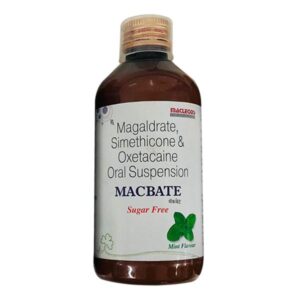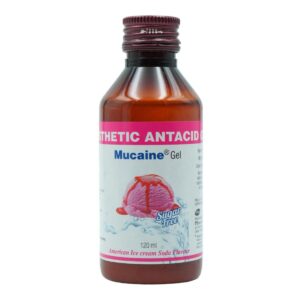MG(OH)2 + AL(OH)3 + OXETHAZAINE
Mg(oh)2: The drug Mg(oh)2, also known as magnesium hydroxide, is commonly used as an antacid and laxative. It works by neutralizing excess stomach acid and relieving symptoms of heartburn, indigestion, and upset stomach.
The mechanism of action of Mg(oh)2 involves an acid-base reaction, where magnesium hydroxide reacts with stomach acid (hydrochloric acid) to form magnesium chloride and water. This reaction helps to decrease the acidity in the stomach, providing relief from symptoms of acid reflux and heartburn.
As an antacid, the typical dose of Mg(oh)2 for adults is 400-1200 mg (2-4 tablets) taken orally, usually after meals and at bedtime, or as directed by a healthcare professional. For the treatment of constipation, the dose may vary, and it is important to follow the instructions provided by your doctor or on the product label.
While generally considered safe, there can be some side effects associated with Mg(oh)2. Common side effects may include diarrhea, gas, stomach cramps, and nausea. These side effects are usually mild and temporary. However, if you experience severe or persistent diarrhea, abdominal pain, or any other unusual symptoms, it is important to consult your healthcare provider.
It is worth noting that individuals with kidney problems or those on a low-magnesium diet should use Mg(oh)2 with caution and under the guidance of a healthcare professional. Additionally, drug interactions may occur with certain medications, so it is essential to inform your healthcare provider of all medications you are taking before starting Mg(oh)2.
Al(oh)3: Al(oh)3, also known as aluminum hydroxide, is an over-the-counter medication commonly used as an antacid and phosphate binder. It belongs to the class of drugs called antacids.
Aluminum hydroxide works by neutralizing excess stomach acid, which helps relieve symptoms of heartburn, indigestion, and sour stomach. Additionally, it can be used to lower phosphate levels in patients with kidney disease, as aluminum hydroxide binds to phosphate in the gastrointestinal tract and prevents its absorption.
The usual dose of aluminum hydroxide for adults and children over 12 years of age is 600-1200 mg every 4 to 6 hours as needed for heartburn or acid indigestion. For patients using it as a phosphate binder, the dose is prescribed by a healthcare professional and may vary depending on the individual’s condition.
While generally considered safe when used as directed, aluminum hydroxide may cause some side effects. Common side effects include constipation or diarrhea, upset stomach, loss of appetite, and nausea. These side effects are usually mild and resolve on their own. However, if they persist or become bothersome, it is advisable to seek medical attention.
Rarely, prolonged or excessive use of aluminum hydroxide can lead to a condition called aluminum toxicity, which can cause symptoms like muscle weakness, bone pain, confusion, seizures, and even organ damage. This complication is more likely to occur in individuals with kidney problems or those who are taking high doses of the medication for an extended period.
It is important to note that aluminum hydroxide may interact with certain medications, such as tetracycline antibiotics, digoxin, and certain blood pressure medications. Therefore, it is important to inform your healthcare provider about all the medications you are taking before using aluminum hydroxide.
In summary, aluminum hydroxide is an antacid and phosphate binder commonly used to relieve symptoms of heartburn, indigestion, and sour stomach. It works by neutralizing stomach acid and binding to phosphate in the intestines. While generally safe, it may cause mild side effects like constipation or diarrhea. Prolonged use or misuse of aluminum hydroxide can lead to aluminum toxicity. Always follow the prescribed dose and consult with a healthcare professional if you have any concerns or questions.
Oxethazaine: Oxethazaine is a local anesthetic drug that is primarily used for the treatment of pain and discomfort associated with various conditions such as mouth ulcers, teething pain, sore throat, and dental procedures. It belongs to the class of drugs known as ester-type local anesthetics.
The mechanism of action of Oxethazaine involves blocking the nerve signals in the affected area, which helps in numbing the area and providing relief from pain. It works by inhibiting the conduction of nerve impulses along the nerve fibers, thereby preventing the transmission of pain signals to the brain.
Oxethazaine is available in the form of a gel or solution and should be applied topically to the affected area. The recommended dose and frequency of application may vary depending on the specific condition being treated. It is important to carefully follow the instructions provided by the healthcare professional or the product label.
As with any medication, Oxethazaine may cause some side effects. Common side effects include local skin reactions such as redness, itching, or irritation at the application site. These side effects are usually mild and temporary. However, if any severe or persistent side effects occur, it is important to discontinue the use of the drug and seek medical attention.
It is worth noting that Oxethazaine is generally considered safe when used as directed. However, it is important to consult with a healthcare professional before using this medication, especially if you have any underlying health conditions or are taking other medications that may interact with Oxethazaine.
Overall, Oxethazaine is a local anesthetic drug that effectively provides relief from pain and discomfort associated with various conditions. However, it is advisable to use this medication according to the prescribed dose and seek medical advice if any concerns or adverse reactions arise.


